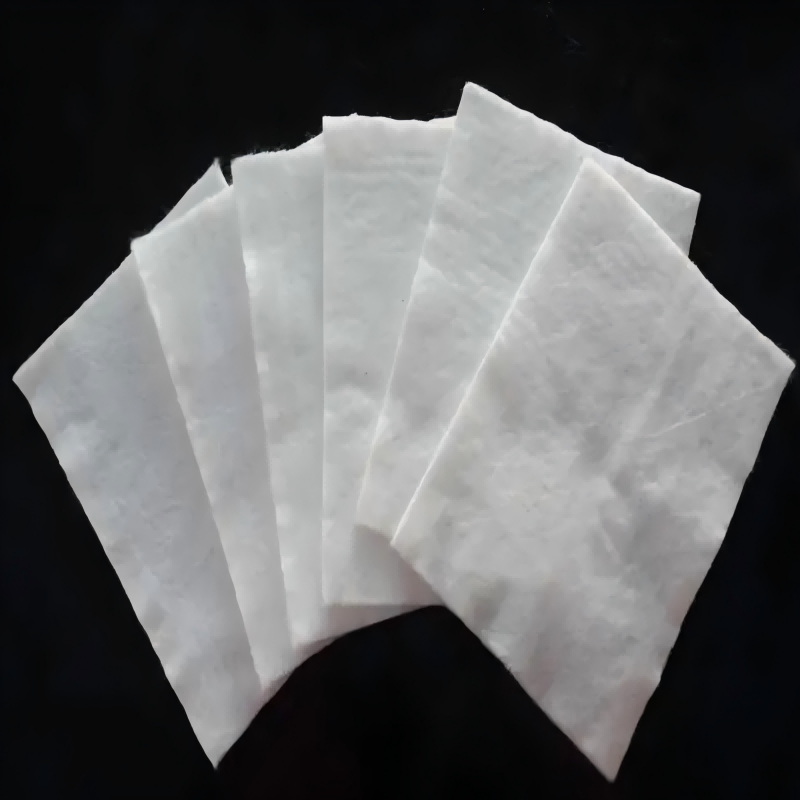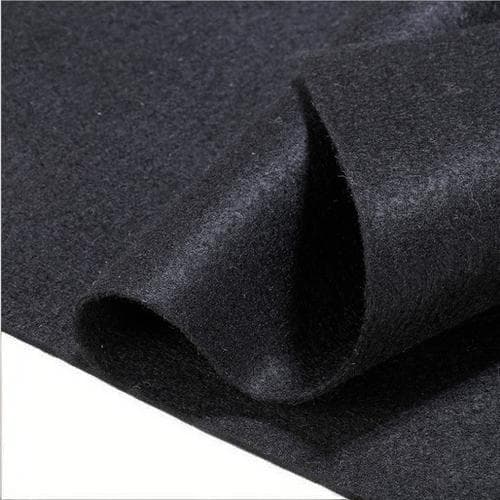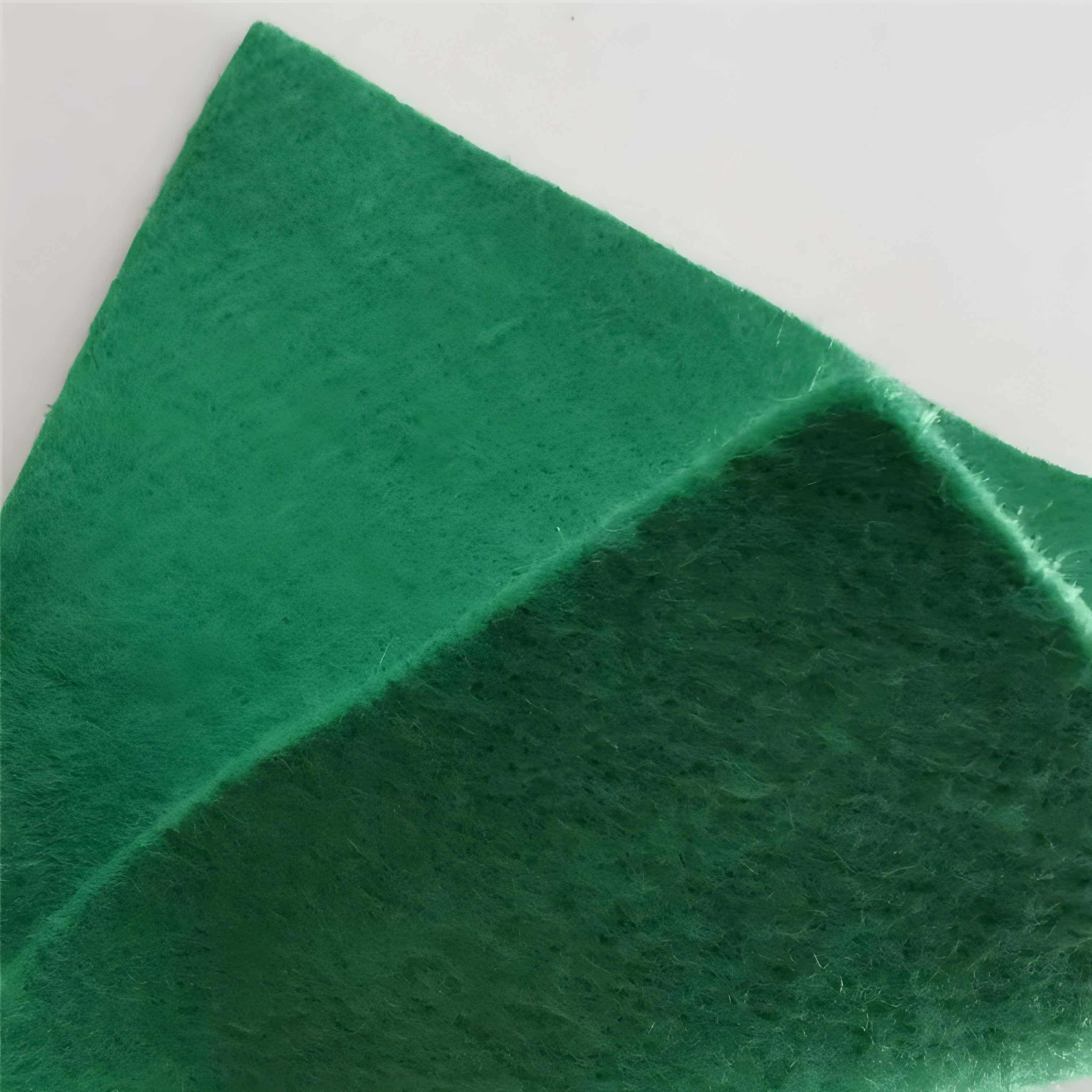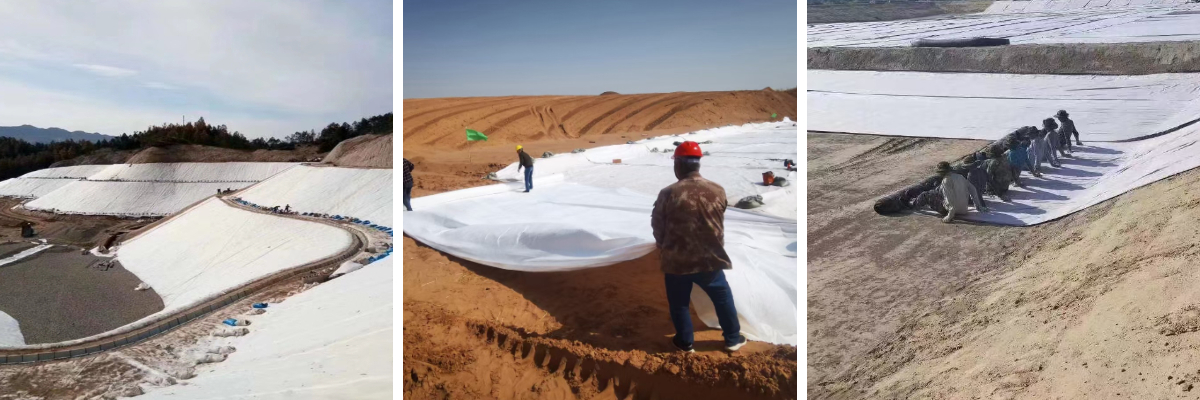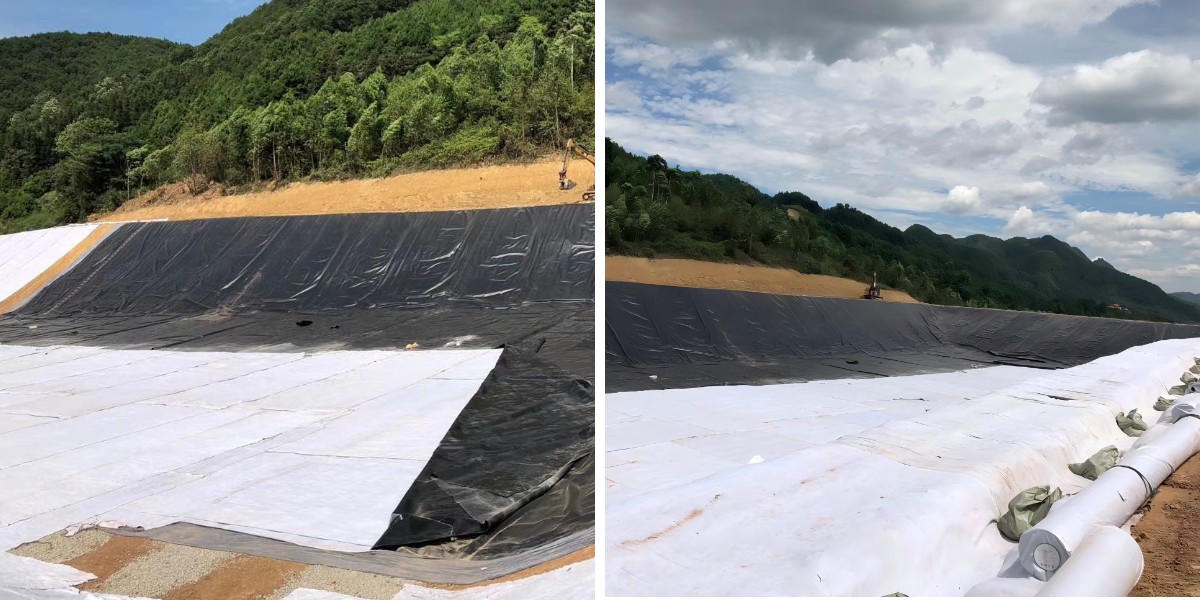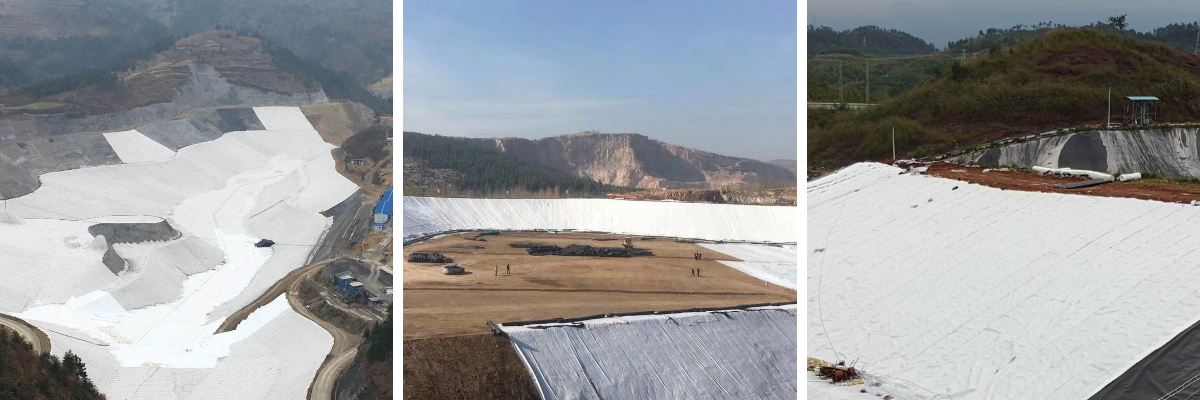Exceed Geotextiles
1.Outstanding filtering performance:Accurately intercept fine soil particles, ensure smooth water flow, avoid engineering blockage or piping, and stabilize water conservancy dams, roadbeds, and other structures.
2.Efficient drainage effect:Porous structure accelerates drainage, reduces soil pore water pressure, reduces slope landslide risk, and facilitates rapid construction of underground engineering.
3.Reliable isolation function:Stable separation of different materials to prevent mixing from affecting performance, such as isolating roadbeds and base layers in roads, and blocking pollutants in landfills.
4.Significant reinforcement and strengthening:High tensile strength enhances the bearing capacity and deformation resistance of soil, reduces embankment settlement, and improves the stability of soft soil foundation.
5.Convenient construction with low cost:Lightweight and easy to transport, suitable for various terrains, with low material and maintenance costs, and high cost-effectiveness.
Product Introduction
1.Basic attributes
Exceed Geotextiles are made from high molecular weight polymers such as polypropylene and polyester, which have good chemical stability and mechanical properties. The production process is diverse, and products made by needle punching technology have high fluffiness and good breathability; The geotextile structure created by weaving technology is compact and has outstanding tensile strength; The hot bonding process can make the fibers bond more firmly and improve overall durability. The final product is mostly a cloth like roll material, with a width usually ranging from 1-6 meters and a length of up to 50-100 meters. The thickness varies from a few millimeters of light and thin type to several tens of millimeters of thick type. It not only has a certain degree of flexibility and can be bent and folded freely to adapt to uneven construction surfaces, but also has considerable tensile strength to withstand the stretching and rolling during the construction process.
2.Core functions
Filtering: In the anti filter layer of hydraulic engineering dams, it can accurately intercept fine particles in the soil of the dam body, prevent them from flowing away with seepage water and causing voids in the dam body, while allowing clear water to penetrate and be discharged smoothly, ensuring the stability of dam seepage; In roadbed construction, rainwater that seeps into the roadbed can be filtered to prevent fine soil particles from blocking drainage channels and maintain the strength of the roadbed structure.
Drainage: In slope engineering, the porous structure is used to quickly divert the accumulated water inside the slope to the drainage system at the foot of the slope, reducing pore water pressure and minimizing the risk of landslides caused by excessive water accumulation on the slope; In the greening of the underground garage roof, excess water in the planting soil layer can be drained in a timely manner to avoid root rot of plants.
Isolation: During road construction, effectively separate the subgrade soil from the sand and gravel base to prevent the hard aggregate of the base from sinking into the weak subgrade and avoid deformation of the subgrade that affects the smoothness of the road surface; In landfills, different types of garbage can be isolated from the surrounding soil to prevent cross contamination of harmful substances.
Reinforcement: In soft soil foundation treatment, laying geotextile can form a composite structure with the foundation soil, improve the tensile and shear strength of the soil, and constrain the settlement and deformation of the foundation; During the process of embankment filling, the pressure of vehicle loads on the bottom of the embankment can be dispersed, improving the bearing capacity of the embankment and reducing road cracking.
3.Main features
It has excellent corrosion resistance and aging resistance, can resist acid and alkali solutions, microbial erosion and ultraviolet radiation, and can maintain long-term stability in wet rivers, saline and alkaline land and other complex environments, with a service life of 10-30 years; Lightweight, usually weighing between 100-600 grams per square meter, easy to transport and handle, with good flexibility, and can be easily laid on irregular terrain surfaces; Strong permeability, large and stable water flow, capable of efficiently achieving filtration and drainage functions; Relatively low cost, compared with traditional materials, it is more economical under the same protective effect; Widely applicable, covering engineering construction in multiple fields such as water conservancy, transportation, municipal engineering, environmental protection, and mining.
Product Parameters
project | metric | ||||||||||
Nominal strength/(kN/m) | |||||||||||
6 | 9 | 12 | 18 | 24 | 30 | 36 | 48 | 54 | |||
1 | Longitudinal and transverse tensile strength / (kN/m) ≥ | 6 | 9 | 12 | 18 | 24 | 30 | 36 | 48 | 54 | |
2 | Maximum elongation at maximum load in longitudinal and transverse directions/% | 30~80 | |||||||||
3 | CBR top penetration strength /kN ≥ | 0.9 | 1.6 | 1.9 | 2.9 | 3.9 | 5.3 | 6.4 | 7.9 | 8.5 | |
4 | Longitudinal and transverse tearing strength /kN | 0.15 | 0.22 | 0.29 | 0.43 | 0.57 | 0.71 | 0.83 | 1.1 | 1.25 | |
5 | Equivalent aperture O.90(O95)/mm | 0.05~0.30 | |||||||||
6 | Vertical permeability coefficient/(cm/s) | K× (10-¹~10-), where K=1.0~9.9 | |||||||||
7 | Width deviation rate /% ≥ | -0.5 | |||||||||
8 | Unit area mass deviation rate /% ≥ | -5 | |||||||||
9 | Thickness deviation rate /% ≥ | -10 | |||||||||
10 | Thickness coefficient of variation (CV)/% ≤ | 10 | |||||||||
11 | Dynamic perforation | Puncture hole diameter/mm ≤ | 37 | 33 | 27 | 20 | 17 | 14 | 11 | 9 | 7 |
12 | Longitudinal and transverse fracture strength (grab method)/kN ≥ | 0.3 | 0.5 | 0.7 | 1.1 | 1.4 | 1.9 | 2.4 | 3 | 3.5 | |
13 | Ultraviolet resistance (Xenon arc lamp method) | Longitudinal and transverse strength retention rate% ≥ | 70 | ||||||||
14 | Ultraviolet resistance (fluorescence UV lamp method) | Longitudinal and transverse strength retention rate% ≥ | 80 | ||||||||
Product Application
1.Water conservancy engineering
In dam construction, geotextile is laid on the upstream face of the dam body or the dam foundation as an anti filter layer to intercept fine soil particles in the dam body, prevent them from forming voids due to seepage, and ensure smooth discharge of seepage, avoiding hidden dangers such as piping and landslides in the dam body. In channel engineering, whether it is irrigation channels or water main channels, geotextiles can be laid on slopes and bottoms to resist water flow erosion, reduce channel collapse, especially in areas with loose soil, which can significantly extend the service life of channels. Combined with other anti-seepage materials, it can also improve water delivery efficiency.
2.Transportation Engineering
During highway construction, geotextile is laid between the roadbed and the pavement base to isolate the roadbed soil from the base sand and gravel, prevent the base aggregate from sinking into the weak roadbed, and use its tensile strength to disperse vehicle loads, reducing roadbed settlement and pavement cracking; In the renovation and expansion of highways, laying geotextile at the junction of old and new road surfaces can alleviate road damage caused by settlement differences. Laying geotextile under railway tracks can filter water seepage from the track bed, prevent fine soil particles from entering the track bed and causing compaction, ensuring the elasticity and drainage of the track bed. In tunnel engineering, geotextile is laid in close contact with the surrounding rock, which can not only discharge water seepage from the surrounding rock, but also prevent debris from blocking the drainage pipes, protecting the tunnel structure from water damage.
3.Municipal Engineering
In the construction of sidewalks and non motorized vehicle lanes on municipal roads, geotextiles can isolate the base layer from the soil base to prevent the increase of soil moisture from affecting the strength of the base layer; Under the hardened ground of urban squares, parking lots, etc., geotextiles can assist in drainage and prevent surface water from seeping into underground structures. When constructing artificial lakes and landscape rivers, geotextiles are laid under the anti-seepage membrane to buffer the friction between the anti-seepage membrane and the base layer, avoiding sharp stones from damaging the anti-seepage membrane. When planting soil on top for vegetation greening, it can also divert the accumulated water under the membrane and prevent the membrane from being damaged due to excessive water pressure.
4.Environmental Protection Engineering
In the anti-seepage system of a landfill site, geotextile is located above the anti-seepage membrane as a protective layer to prevent sharp objects in the garbage from puncturing the anti-seepage membrane. Below it, it can be used as a filtering layer to filter the leachate from the landfill site and prevent impurities from blocking the drainage blind ditch. In the sludge treatment area of sewage treatment plants, geotextiles can be used for sludge dewatering and filtration, intercepting solid particles of sludge, allowing water to pass through and be discharged, and improving sludge dryness; Laying geotextile on the walls and bottoms of facilities such as oxidation tanks and sedimentation tanks can prevent soil pollution of the treated water body and assist in water circulation and filtration.
Geotextiles play an irreplaceable role in many fields such as water conservancy, transportation, municipal engineering, and environmental protection, thanks to their multiple functions of filtration, drainage, isolation, and reinforcement. It can not only ensure the stability and safety of engineering structures, extend the service life of engineering, but also prevent the spread of pollutants in environmental protection and assist in the rational utilization of water resources. It is an important material for improving engineering quality and reducing maintenance costs in modern engineering construction. Its wide applicability and significant practical value make it a key component of engineering construction in various industries.


